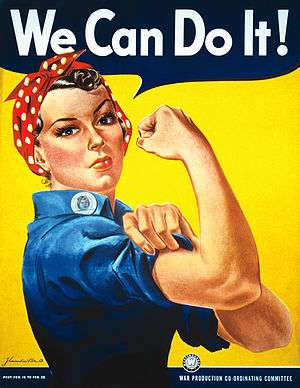Geraldine Doyle
| Geraldine Doyle | |
|---|---|
 Hoff in 1942 at age 17 | |
| Born |
July 31, 1924 Inkster, Michigan, U.S. |
| Died |
December 26, 2010 (aged 86) Lansing, Michigan, U.S. |
| Cause of death | Complications from arthritis |
| Nationality | American |
| Other names | Geraldine Hoff Doyle |
| Known for | Disproved claim to be the model for the "We Can Do It!" poster |
| Spouse(s) | Dr. Leo H. Doyle, DDS (m. 1943–2010) |
| Children | 6 |

Geraldine Hoff Doyle (July 31, 1924 – December 26, 2010)[1] has been widely promoted in the media as the possible real-life model for the World War II era "We Can Do It!" poster, later thought to be an embodiment of the iconic World War II character Rosie the Riveter. However, the 1942 news wire service photograph may depict another young war worker, Naomi Parker.[2][3][4][5]
Life
Geraldine Hoff was born in Inkster, Michigan. Her father Cornelious was an electrical contractor who died of pneumonia when she was 10 years old. Her mother, Augusta, was a composer who had scoliosis. After graduating from high school in Ann Arbor, Michigan, in 1942 Hoff found work as a metal presser in the American Broach & Machine Co. of Ann Arbor.[1][6] As men started enlisting and being drafted into military service for World War II, women began to support the war effort by taking on roles, including factory work, that were formerly considered "male-only."
Because she was a cellist, Hoff feared a hand injury from the metal pressing machines and so she left the factory after having worked for only a couple weeks.[1][7] During the brief time she worked there, according to Doyle, a United Press International photographer took a picture of her. Soon after quitting work as a metal presser, Geraldine Hoff met and married dentist Leo Doyle in 1943. The couple had six children (a son, Gary, died in 1980) and remained married until his death in February 2010.[1]

Claim of connection to "We Can Do It!" Poster
Because the "We Can Do It!" poster was created for an internal Westinghouse project, it did not become widely known until the 1980s, when it was rediscovered and used by advocates of women's equality in the workplace. In 1984, Doyle came across an article in Modern Maturity magazine which showed a photo of an unidentified young war worker at a turret lathe. In 1994, Doyle saw the "We Can Do It!" poster on the cover of the Smithsonian magazine. Doyle felt she recognized herself in both the photo and the poster[8] and in the 1990s communicated with historian and author Penny Colman of her connection to the photo and therefore to the poster.[9] News media outlets, upon Doyle's death, memorialized her as the model for the famous poster, without citing evidence beyond Doyle's assertions.[1][3][6][7][8][10] Doyle assumed that the photograph had inspired the poster.[2] Later evidence,[11] however, reveals that the press photo actually shows California war worker Naomi Parker, the photo taken at Naval Air Station Alameda in March 1942,[4][5][12] at a time when Doyle was attending high school.[2] Doyle did not claim to have met or sat for poster artist J. Howard Miller, but only to have been the woman depicted in this particular press photo which many believe inspired the poster.[6][9] The ACME Newspictures wire service image of Naomi Parker was used as the cover image for the Time-Life book The Patriotic Tide: 1940-1950 published in 1986.[10][13]
The "We Can Do It!" image remains an icon and appeared on a 1999 postage stamp as part of a World War II series produced by the U.S. Postal Service.[14]
Death
Geraldine Hoff Doyle died on December 26, 2010, in Lansing, Michigan, as a result of complications from severe arthritis.[1][10] She was survived by her five children, eighteen grandchildren and twenty-five great-grandchildren.[15]
References
- 1 2 3 4 5 6 McLellan, Dennis (December 31, 2010). "Geraldine Hoff Doyle dies at 86; inspiration behind a famous wartime poster". Los Angeles Times. Retrieved 31 December 2010.
- 1 2 3 Kimble, James J. (Summer 2016). "Rosie's Secret Identity, or, How to Debunk a Woozle by Walking Backward through the Forest of Visual Rhetoric". Rhetoric and Public Affairs. 19 (2): 245–274. ISSN 1094-8392.
- 1 2 "Michigan Woman Who Inspired WWII 'Rosie' Poster Has Died : The Two-Way : NPR". 2015-09-09. Archived from the original on September 9, 2015. Retrieved 2016-03-01.
- 1 2 "Museum Collections, U.S. National Park Service -". museum.nps.gov. Retrieved 2016-03-01.
- 1 2 "All This and Overtime, Too - 42-62386550 - Rights Managed - Stock Photo - Corbis". www.corbisimages.com. Retrieved 2016-03-01.
- 1 2 3 Geraldine Doyle: Obituary - legacy.com
- 1 2 Geraldine Doyle, inspiration for 'Rosie the Riveter,' dies at 86 published December 30, 2010 by NBC News: "Geraldine Doyle left her factory job after two weeks"
- 1 2 Chuck, Elizabeth (December 30, 2010). "Geraldine Doyle, inspiration for 'Rosie the Riveter,' dies at 86". Field Notes from NBC News. Archived from the original on January 1, 2011. Retrieved July 1, 2015.
- 1 2 "Rosie the Riveter Image | Penny Colman". 2011-04-28. Archived from the original on April 28, 2011. Retrieved 2016-03-02.
- 1 2 3 Shapiro, T. Rees - Washington Post Staff Writer (2011-12-29). "Geraldine Doyle, 86, dies; one-time factory worker inspired Rosie the Riveter and 'We Can Do It!' poster". The Washington Post. Retrieved September 6, 2012.
- ↑ KRCR. "Northstate woman shares experience as 'Rosie'". KRCRTV. Retrieved 2016-03-02.
- ↑ "Naomi Parker Fraley". www.naomiparkerfraley.com. Retrieved 2016-03-01.
- ↑ The Patriotic Tide: 1940–1950 (This Fabulous Century). Time-Life Education. 1986. pp. cover image. ISBN 0809482002.
- ↑ Diversity Development (April 2003). "Women on Stamps" (PDF). Publication 512. United States Postal Service. p. 24. Retrieved September 6, 2012.
- ↑ Moss, Hilary (December 30, 2010). "Geraldine Hoff Doyle Dead: 'Rosie The Riveter' Inspiration Dies At 86". Huffington Post. Retrieved 1 January 2011.